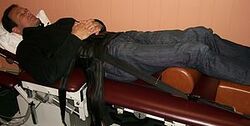Vertebrogenic algic syndrome
Vertebrogenic pain syndrome(VAS) is defined as pain localized in various areas of the spine with limitation of mobility of the spinal section, with or without neurological symptoms.
Division of VAS according to its causes[edit | edit source]
Structural point of view[edit | edit source]
Structural changes that can be observed on imaging methods (e.g. X- ray) are understood as the cause of pain and movement difficulties. If the cause is structural, treatment falls within the competence of orthopedics or neurology.
Functional point of view[edit | edit source]
Using imaging methods, no pathology is clearly evident to account for the difficulties. However, we see a clear functional disorder. In these cases, rehabilitation is the appropriate treatment.
Types of VAS according to location[edit | edit source]
Cervicocranial syndrome(CK syndrome)[edit | edit source]
These are headaches that have their cause in the area of the upper cervical spine. Current pain in the cervical spine or its blockage is not a condition. Pain appears mainly after exercise, psychogenic factors also play a significant role. Dizziness is also often described.
Cervicobrachial syndrome(CB syndrome)[edit | edit source]
These are upper extremity pains that originate in the lower part of the cervical spine. It is often and misdiagnosed as frozen shoulder syndrome.
Lumbargia[edit | edit source]
This is a very long-known disease, its clinical symptoms were already described by Hippocrates. Although the clinical picture is almost identical in almost all cases, there can be several causes, from congenital defects of the spine, tumors, injuries to diseases of internal organs or the spine, which is why correct diagnosis is difficult.
Causes of back pain[edit | edit source]
The causes of back pain are very diverse and diagnosis is extremely difficult. It can be a functional blockage in a spinal segment, an overload of the fibrous or muscular apparatus, a congenital or acquired deformity. We can also look for causes in degenerative diseases of the spine, spondylolisthesis, osteoporosis or diseases of internal organs.
Therapy[edit | edit source]
For conservative therapy, mainly pharmacological treatment( analgesics) combined with rehabilitation is used, in more severe cases, when conservative therapy does not work, surgery is also suitable.
Links[edit | edit source]
Related articles[edit | edit source]
Literature[edit | edit source]
- KASIK, Jiří. Vertebrogenní kořenové syndromy : diagnostika a léčba. 1. edition. Prague : Grada, 2002. ISBN 80-247-0142-1.


